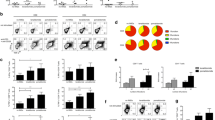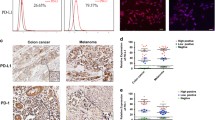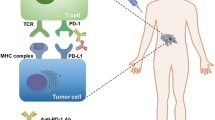Abstract
Dendritic cell (DC)-based vaccines are recognized as a promising immunotherapeutic strategy against cancer; however, the efficacy of immunotherapy with DCs is controlled via immune checkpoints, such as programmed death-ligand 1 (PD-L1). PD-L1 expressed on DC and tumor cells binds to programmed death-1 (PD-1) receptors on the activated T cells, which leads to the inhibition of cytotoxic T cells. Blocking of PD-L1 on DC may lead to improve the efficacy of DC therapy for cancer. Here we demonstrated that DC vaccination in combination with pomalidomide and programmed death-ligand 1 (PD-L1) blockade inhibited tumor growth of a multiple myeloma (MM) mouse model. DCs + pomalidomide with dexamethasone + PD-L1 blockade significantly inhibited immune immunosuppressive factors and promoted proportions of immune effector cells in the spleen and tumor microenvironment. Additionally, functional activities of cytotoxic T lymphocytes and NK cells in spleen were enhanced by DCs + pomalidomide with dexamethasone + PD-L1 blockade. Taken together, this study identifies a potential new therapeutic approach for the treatment of MM. These results also provide a foundation for the future development of immunotherapeutic modalities to inhibit tumor growth and restore immune function in MM.







Similar content being viewed by others
Data availability
The data that support the findings of this study are openly available in 17th International Myeloma Workshop September 2019 at https://doi.org/10.1016/j.clml.2019.09.272 [51], and the 62nd American Society of Hematology Annual Meeting & Exposition 2019 at https://doi.org/10.1182/blood-2019-127964 [52].
Abbreviations
- BM:
-
Bone marrow
- CTLA4:
-
Cytotoxic T-lymphocyte-associated protein 4
- CTLs:
-
Cytotoxic T lymphocytes
- DC:
-
Dendritic cell
- DMEM:
-
Dulbecco’s modified Eagle’s medium
- DMSO:
-
Dimethylsulfoxide
- ELISA:
-
Enzyme-linked immunosorbent
- ELISPOT:
-
Interferon (IFN)-γ enzyme-linked immunospot
- FBS:
-
Fetal bovine serum
- GM-CSF:
-
Granulocyte–macrophage colony-stimulating factor
- imDC:
-
Immature DC
- IMiDs:
-
Immunomodulatory drugs
- MM:
-
Multiple myeloma
- MOPC:
-
Mineral-oil-induced plasmacytomas
- MHC:
-
Major histocompatibility
- MDSCs:
-
Myeloid-derived suppressor cells
- mAbs:
-
Monoclonal antibodies
- NK:
-
Natural killer
- PD-1:
-
Programmed death-1
- PD-L1:
-
Programmed death-ligand 1
- PC:
-
Plasma cell
- PBS:
-
Phosphate-buffered saline
- PIs:
-
Proteasome inhibitors
- PS:
-
Penicillin/streptomycin
- rm:
-
Recombinant murine
- rmIL:
-
Recombinant mouse interleukin
- TNF-α:
-
Tumor necrosis factor-alpha
- Th1:
-
T helper type 1
- Tregs:
-
Regulatory T cells
- TGF-β:
-
Transforming growth factor-beta
- VEGF:
-
Vascular endothelial growth factor
References
Jung SH, Lee HJ, Vo MC, Kim HJ, Lee JJ (2017) Immunotherapy for the treatment of multiple myeloma. Crit Rev Oncol Hematol 111:87–93
Görgün GT, Whitehill G, Anderson JL, Hideshima T, Maguire C, Laubach J et al (2013) Tumor-promoting immune-suppressive myeloid-derived suppressor cells in the multiple myeloma microenvironment in humans. Blood 121(15):2975–2987
Kane RC, Farrell AT, Sridhara R, Pazdur R (2006) United States food and drug administration approval summary: bortezomib for the treatment of progressive multiple myeloma after one prior therapy. Clin Cancer Res 12(10):2955–2960
Kumar SK, Gertz MA (2014) Risk adapted therapy for multiple myeloma: back to basics. Leuk Lymphoma 55(10):2219–2220
Rosenblatt J, Avigan D (2008) Cellular immunotherapy for multiple myeloma. Best Pract Res Clin Haematol 21(3):559–577
Vo MC, Yang S, Jung SH, Chu TH, Lee HJ, Lakshmi TJ et al (2018) Synergistic antimyeloma activity of dendritic cells and pomalidomide in a murine myeloma model. Front Immunol 9:1798
Vo MC, Lakshmi TJ, Jung SH, Cho D, Park HS, Chu TH, Lee HJ, Kim HJ, Kim SK, Lee JJ (2019) Cellular immunotherapy in multiple myeloma. Korean J Intern Med 34(5):954–965
Hong CY, Lee HJ, Choi NR, Jung SH, Vo MC, Hoang MD, Kim HJ, Lee JJ (2016) Sarcoplasmic reticulum Ca(2+) ATPase 2 (SERCA2) reduces the migratory capacity of CCL21-treated monocyte-derived dendritic cells. Exp Mol Med 48(8):e253
Kim YS, P HJ, Park JH, Hong EJ, Jang GY, Jung ID, Han HD, Lee SH, Vo MC et al (2018) A novel function of API5 (apoptosis inhibitor 5), TLR4-dependent activation of antigen presenting cells. Oncoimmunology 7(10):e1472187
Park HJ, Jand GY, Kim YS, Park JH, Lee SE, Vo MC, Lee JJ et al (2019) A novel TLR4 binding protein, 40S ribosomal protein S3, has potential utility as an adjuvant in a dendritic cell-based vaccine. J Immunother Cancer 7(1):60
Vo MC, Nguyen-Pham TN, Lee HJ, Jung SH, Choi NR, Hoang MD, Kim HJ, Lee JJ (2017) Chaetocin enhances dendritic cell function via the induction of heat shock protein and cancer testis antigens in myeloma cells. Oncotarget 8(28):46047–46056
Choi NR, Lee HJ, Jung SH, Hong CY, Vo MC, Hoang MD, Kim HJ, Lee JJ (2015) Generation of potent dendritic cells with improved migration ability through p-cofilin and sarco/endoplasmic reticulum Ca(2+) transport ATPase 2 regulation. Cytotherapy 17(10):1421–1433
Jung SH, Lee YK, Lee HJ, Choi NR, Vo MC, Hoang MD, Lim MS, Nguyen-Pham TN, Kim HJ, Lee JJ (2014) Dendritic cells loaded with myeloma cells pretreated with a combination of JSI-124 and bortezomib generate potent myeloma-specific cytotoxic T lymphocytes in vitro. Exp Hematol 42(4):274–281
Vo MC, Jung SH, Chu TH, Lee HJ, Lakshmi TJ, Park HS et al (2018) Lenalidomide and programmed death-1 blockade synergistically enhances the effects of dendritic cell vaccination in a model of murine myeloma. Front Immunol 9:1370
Vo MC, Nguyen-Pham TN, Lee HJ, Jaya Lakshmi T, Yang S, Jung SH et al (2017) Combination therapy with dendritic cells and lenalidomide is an effective approach to enhance antitumor immunity in a mouse colon cancer model. Oncotarget 18(16):27252–27262
Nguyen-Pham TN, Jung SH, Vo MC, Thanh-Tran HT, Lee YK, Lee HJ, Choi NR, Hoang MD, Kim HJ, Lee JJ (2015) Lenalidomide synergistically enhances the effect of dendritic cell vaccination in a model of murine multiple myeloma. J Immunother 38(8):330–3399
Nguyen-Pham TN, Lee YK, Kim HJ, Lee JJ (2012) Immunotherapy using dendritic cells against multiple myeloma: how to improve? Clin Dev Immunol 2012:397648
Hoang MD, Jung SH, Lee HJ, Lee YK, Nguyen-Pham TN, Choi NR et al (2015) Dendritic cell-based cancer immunotherapy against multiple myeloma: from bench to clinic. Chonnam Med J 51(1):1–7
Francisco LM, Salinas VH, Brown KE, Vanguri VK, Freeman GJ, Kuchroo VK et al (2009) PD-L1 regulates the development, maintenance, and function of induced regulatory T cells. J Exp Med 206(13):3015–3029
Köhler M, Greil C, Hudecek M, Lonial S, Raje N, Wäsch R et al (2018) Current developments in immunotherapy in the treatment of multiple myeloma. Cancer 124(10):2075–2085
Chanan-Khan AA, Swaika A, Paulus A, Kumar SK, Mikhael JR, Rajkumar SV et al (2013) Pomalidomide: the new immunomodulatory agent for the treatment of multiple myeloma. Blood Cancer J 3:e143
Mark TM, Coleman M, Niesvizky R (2014) Preclinical and clinical results with pomalidomide in the treatment of relapsed/refractory multiple myeloma. Leuk Res 38(5):517–524
Richardson PG, Mark TM, Lacy MQ (2013) Pomalidomide: new immunomodulatory agent with potent antiproliferative effects. Crit Rev Oncol Hematol 88(Suppl 1):S36–44
Bristol-myers squibb (NYSE: BMY) (2018) US. Food and drug administration accepts for priority review bristol-myers squibb’s application for empliciti (elotuzumab) plus pomalidomide and low-dose dexamethasone in patients with relapsed or refractory multiple myeloma. Link: https://news.bms.com/press-release/bristolmyers/us-food-and-drug-administration-accepts-priority-review-bristol-myers-squ. Accessed 25 Feb 2020
Dong H, Strome S, Salomao DR, Tamura H, Hirano F, Flies DB et al (2002) Tumor-associated B7–H1 promotes T-cell apoptosis: a potential mechanism of immune evasion. Nat Med 8(8):793–800
Freeman GJ, Long AJ, Iwai Y, Bourque K, Chernova T, Nishimura H et al (2000) Engagement of the PD-1 immunoinhibitory receptor by a novel B7 family member leads to negative regulation of lymphocyte activation. J Exp Med 192(7):1027–1034
Robert C, Thomas L, Bondarenko I, O'Day S, Weber J, Garbe C et al (2011) Ipilimumab plus dacarbazine for previously untreated metastatic melanoma. N Engl J Med 364(26):2517–2526
Keir ME, Liang SC, Guleria I, Latchman YE, Qipo A, Albacker LA et al (2006) Tissue expression of PD-L1 mediates peripheral T cell tolerance. J Exp Med 203(4):883–895
Tamura H, Ishibashi M, Yamashita T, Tanosaki S, Okuyama N, Kondo A et al (2013) Marrow stromal cells induce B7–H1 expression on myeloma cells, generating aggressive characteristics in multiple myeloma. Leukemia 27(2):464–472
Jelinek T, Hajek R (2016) PD-1/PD-L1 inhibitors in multiple myeloma: the present and the future. Oncoimmunology 5(12):e1254856
Benson DM Jr, Bakan CE, Mishra A, Hofmeister CC, Efebera Y, Becknell B et al (2010) The PD-1/PD-L1 axis modulates the natural killer cell versus multiple myeloma effect: a therapeutic target for CT-011, a novel monoclonal anti-PD-1 antibody. Blood 116(13):2286–2294
Luptakova K, Rosenblatt J, Glotzbecker B, Mills H, Stroopinsky D, Kufe T et al (2013) Lenalidomide enhances anti-myeloma cellular immunity. Cancer Immunol Immunother 62(1):39–49
Sedlarikova L, Kubiczkova L, Sevcikova S, Hajek R (2012) Mechanism of immunomodulatory drugs in multiple myeloma. Leuk Res 36(10):1218–1224
Alsaab HO, Sau S, Alzhrani R, Tatiparti K, Bhise K, Kashaw SK, Iyer AK (2017) PD-1 and PD-l1 checkpoint signaling inhibition for cancer immunotherapy: mechanism, combinations, and clinical outcome. Front Pharmacol 8:561
Vo MC, Lee HJ, Kim JS, Hoang MD, Choi NR, Rhee JH et al (2015) Dendritic cell vaccination with a toll-like receptor agonist derived from mycobacteria enhances anti-tumor immunity. Oncotarget 6(32):33781–33790
Banchereau J, Palucka AK (2005) Dendritic cells as therapeutic vaccines against cancer. Nat Rev Immunol 5(4):296–306
Nikitina EY, Gabrilovich D (2001) Combination of gamma-irradiation and dendritic cell administration induces a potent antitumor response in tumor-bearing mice: approach to treatment of advanced stage cancer. Int J Cancer 94(6):825–833
Romano A, Conticello C, Cavalli M, Vetro C, La Fauci A, Parrinello NL et al (2014) Immunological dysregulation in multiple myeloma microenvironment. Biomed Res Int 2014:198539
Sounni NE, Noel A (2013) Targeting the tumor microenvironment for cancer therapy. Clin Chem 59(1):85–93
Vo MC, Anh-Nguyen Thi T, Lee HJ, Nguyen-Pham TN, Jaya Lakshmi T, Jung SH et al (2017) Lenalidomide enhances the function of dendritic cells generated from patients with multiple myeloma. Exp Hematol 46:48–55
He J, Hu Y, Hu M, Li B (2015) Development of PD-1/PD-L1 pathway in tumor immune microenvironment and treatment for non-small cell lung cancer. Sci Rep 5:13110
Boussiotis VA, Chatterjee P, Li L (2014) Biochemical signaling of PD-1 on T cells and its functional implications. Cancer J 20(4):265–271
Juneja VR, McGuire KA, Manguso RT, LaFleur MW, Collins N, Haining WN et al (2017) PD-L1 on tumor cells is sufficient for immune evasion in immunogenic tumors and inhibits CD8 T cell cytotoxicity. J Exp Med 214(4):895–904
Kowanetz M, Zou W, Gettinger SN, Koeppen H, Kockx M, Schmid P et al (2018) Differential regulation of PD-L1 expression by immune and tumor cells in NSCLC and the response to treatment with atezolizumab (anti-PD-L1). Proc Natl Acad Sci USA 115(43):E10119–E10126
Tremblay-LeMay R, Rastgoo N, Chang H (2018) Modulating PD-L1 expression in multiple myeloma: an alternative strategy to target the PD-1/PD-L1 pathway. J Hematol Oncol 11(1):46
Lwin ST, Edwards CM, Silbermann R (2016) Preclinical animal models of multiple myeloma. Bonekey Rep 5:772
Tassone P, Neri P, Burger R, Di Martino MT, Leone E, Amodio N et al (2012) Mouse models as a translational platform for the development of new therapeutic agents in multiple myeloma. Curr Cancer Drug Targets 12(7):814–822
Abdallah N, Kumar SK (2019) Daratumumab in untreated newly diagnosed multiple myeloma. Ther Adv Hematol 10:2040620719894871
Fancher KM, Bun EJ (2016) Elotuzumab: the first monoclonal antibody for the treatment of multiple myeloma. J Adv Pract Oncol 7(5):542–547
Shah UA, Mailankody S (2020) CAR T and CAR NK cells in multiple myeloma: expanding the targets. Best Pract Res Clin Haematol 33(1):101141
Lee J-J, Jung S-H, Chu T-H, Vo M-C, Park H-S, Kim H-J (2019) Potent anti-myeloma efficacy of dendritic cell therapy in combination with pomalidomide and programmed death-ligand 1 blockade in a preclinical model of multiple myeloma 17th international myeloma workshop September 2019. Clin Lymp Myeloma Leuk 19(10):e163. https://doi.org/10.1016/j.clml.2019.09.272
Lee J-J, Chu T-H, Vo M-C, Park H-S, Lakshmi TJ, Ahn S-Y, Song G-Y, Jung S-H, Kim H-J (2019) A combination therapy with dendritic cells, pomalidomide and programmed death-ligand 1 blockade exerts a potent antitumor immunity in a murine model of multiple myeloma. 2019 by the American society of hematology. Blood. https://doi.org/10.1182/blood-2019-127964(134 Supplement_1: 1819)
Acknowledgements
Je-jung Lee has received honoraria for speaking at the 17th international myeloma workshop september 2019 [51], and the 62nd American Society of Hematology Annual Meeting and Exposition 2019 [52].
Funding
This research was supported by grants (2018R1A5A2024181, NRF-2018R1C1B5041536, NRF-2020R1A2C2010098) from the National Research Foundation of Korea (NRF), funded by the Ministry of Education, Science, and Technology (MEST), Republic of Korea.
Author information
Authors and Affiliations
Contributions
MCV, THC, SHJ, and JJL designed the study. MCV, THC, HSP, and TJL performed the research and analyzed the data. MCV and JJL wrote the article. JJL, SHJ, and HJK contributed intellectually to the research.
Corresponding authors
Ethics declarations
Conflict of interest
The authors declare no conflicts of interest.
Additional information
Publisher's Note
Springer Nature remains neutral with regard to jurisdictional claims in published maps and institutional affiliations.
Electronic supplementary material
Below is the link to the electronic supplementary material.
Rights and permissions
About this article
Cite this article
Chu, TH., Vo, MC., Park, HS. et al. Potent anti-myeloma efficacy of dendritic cell therapy in combination with pomalidomide and programmed death-ligand 1 blockade in a preclinical model of multiple myeloma. Cancer Immunol Immunother 70, 31–45 (2021). https://doi.org/10.1007/s00262-020-02654-0
Received:
Accepted:
Published:
Issue Date:
DOI: https://doi.org/10.1007/s00262-020-02654-0




